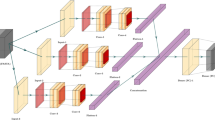Abstract
The diversification of the characteristic sequences of anti-cancer peptides has imposed difficulties on research. To effectively predict new anti-cancer peptides, this paper proposes a more suitable feature grouping sequence and spatial dimension-integrated network algorithm for anti-cancer peptide sequence prediction called GRCI-Net. The main process is as follows: First, we implemented the fusion reduction of binary structure features and K-mer sparse matrix features through principal component analysis and generated a set of new features; second, we constructed a new bidirectional long- and short-term memory network. We used traditional convolution and dilated convolution to acquire features in the spatial dimension using the memory network's grouping sequence model, which is designed to better handle the diversification of anti-cancer peptide feature sequences and to fully learn the contextual information between features. Finally, we achieved the fusion of grouping sequence features and spatial dimensional integration features through two sets of dense network layers, achieved the prediction of anti-cancer peptides through the sigmoid function, and verified the approach with two public datasets, ACP740 (accuracy reached 0.8230) and ACP240 (accuracy reached 0.8750). The following is a link to the model code and datasets mentioned in this article: https://github.com/ YouHongfeng101/ACP-DL.





Similar content being viewed by others
References
Rao B, Zhou C, Zhang G et al (2020) ACPred-Fuse: fusing multi-view information improves the prediction of Anti-cancer peptides[J]. Brief Bioinform 21(5):1846–1855. https://doi.org/10.1093/bib/bbz088
Gabernet G, Gautschi D, Müller AT et al (2019) In silico design and optimization of selective membranolytic Anti-cancer peptides[J]. Sci Rep 9(1):1–11. https://doi.org/10.1038/s41598-019-47568-9
Grisoni F, Neuhaus CS, Hishinuma M et al (2019) De novo design of Anti-cancer peptides by ensemble artificial neural networks[J]. J Mol Model. https://doi.org/10.1007/s00894-019-4007-6
Manavalan B, Basith S, Shin TH, et al (2017) MLACP: Machine-learning-based prediction of Anti-cancer peptides[J]. Oncotarget 8(44): 77121–77136. https://doi.org/10.18632/oncotarget.20365
Schaduangrat N, Nantasenamat C, Prachayasittikul V et al (2019) ACPred: a computational tool for the prediction and analysis of Anti-cancer peptides[J]. Molecules 24(10):1973. https://doi.org/10.3390/molecules24101973
Wan Y, Wang Z, Lee TY (2021) Incorporating support vector machine with sequential minimal optimization to identify Anti-cancer peptides[J]. BMC Bioinform 22(1):1–16. https://doi.org/10.1186/s12859-021-03965-4
Wei L, Ding Y, Su R et al (2018) Prediction of human protein subcellular localization using deep learning[J]. J Parallel Distrib Comput 117:212–217. https://doi.org/10.1016/j.jpdc.2017.08.009
Zou Q, Xing P, Wei L et al (2019) Gene2vec: gene subsequence embedding for prediction of mammalian N6-methyladenosine sites from mRNA[J]. RNA 25(2):205–218. https://doi.org/10.1261/rna.069112.118
Chen W, Feng P, Yang H et al (2018) iRNA-3typeA: identifying three types of modification at RNA’s adenosine sites[J]. Mol Therapy Nucleic Acids 11:468–474. https://doi.org/10.1016/j.omtn.2018.03.012
Jiao Y, Du P (2016) Performance measures in evaluating machine learning based bioinformatics predictors for classifications[J]. Quantit Biol 4(4):320–330. https://doi.org/10.1007/s40484-016-0081-2
Du P, Tian Y, Yan Y (2012) Subcellular localization prediction for human internal and organelle membrane proteins with projected gene ontology scores[J]. J Theor Biol 313:61–67. https://doi.org/10.1016/j.jtbi.2012.08.016
Wang Y, You Z, Li L et al (2020) A survey of current trends in computational predictions of protein-protein interactions[J]. Front Comp Sci 14(4):144901. https://doi.org/10.1007/s11704-019-8232-z
Li S, You ZH, Guo H et al (2015) Inverse-free extreme learning machine with optimal information updating[J]. IEEE Trans Cybernet 46(5):1229–1241. https://doi.org/10.1109/TCYB.2015.2434841
Zhu L, You ZH, Huang DS (2013) Increasing the reliability of protein-protein interaction networks via non-convex semantic embedding[J]. Neurocomputing 121:99–107. https://doi.org/10.1016/j.neucom.2013.04.027
Chen ZH, You ZH, Li LP et al (2019) Prediction of self-interacting proteins from protein sequence information based on random projection model and fast Fourier transform[J]. Int J Mol Sci 20(4):930. https://doi.org/10.3390/ijms20040930
Yi HC, You ZH, Zhou X et al (2019) ACP-DL: a deep learning long short-term memory model to predict Anti-cancer peptides using high-efficiency feature representation[J]. Mol Therapy Nucleic Acids 17:1–9. https://doi.org/10.1016/j.omtn.2019.04.025
Yu L, Jing R, Liu F et al (2020) DeepACP: a novel computational approach for accurate identification of Anti-cancer peptides by deep learning algorithm[J]. Mol Therapy Nucleic Acids 22:862–870. https://doi.org/10.1016/j.omtn.2020.10.005
Ahmed S, Muhammod R, Adilina S et al (2020) ACP-MHCNN: An Accurate Multi-Headed Deep-Convolutional Neural Network to Predict Anti-cancer peptides[J]. bioRxiv. https://doi.org/10.1101/2020.09.25.313668
Lane N, Kahanda I (2020) DeepACPpred: a novel hybrid cnn-rnn architecture for predicting anti-cancer peptides[C]. Int Conf Pract Applic Comput Biol Bioinform. https://doi.org/10.1007/978-3-030-54568-0_7
Shao YT, Chou KC (2020) pLoc_Deep-mAnimal: A novel deep cnn-blstm network to predict subcellular localization of animal proteins[J]. Nat Sci 12(5):281–291. https://doi.org/10.4236/ns.2020.125024
Fang C, Moriwaki Y, Li C et al (2019) Prediction of antifungal peptides by deep learning with character embedding[J]. IPSJ Trans Bioinform 12:21–29. https://doi.org/10.2197/ipsjtbio.12.21
Yan J, Bhadra P, Li A et al (2020) Deep-AmPEP30: improve short antimicrobial peptides prediction with deep learning[J]. Mol Therapy-Nucleic Acids 20:882–894. https://doi.org/10.1016/j.omtn.2020.05.006
Rao B, Zhang L, Zhang G (2020) ACP-GCN: the identification of Anti-cancer peptides based on graph convolution networks[J]. IEEE Access 8:176005–176011. https://doi.org/10.1109/ACCESS.2020.3023800
Chen W, Ding H, Feng P, et al (2016) iACP: a sequence-based tool for identifying Anti-cancer peptides[J]. Oncotarget 7(13): 16895–16909. https://doi.org/10.18632/oncotarget.7815
You H, Tian S, Yu L et al (2019) Pixel-level remote sensing image recognition based on bidirectional word vectors[J]. IEEE Trans Geosci Remote Sens 58(2):1281–1293. https://doi.org/10.1109/TGRS.2019.2945591
Zhang J, Liu F, Xu W et al (2019) Feature fusion text classification model combining CNN and BiGRU with multi-attention mechanism[J]. Future Internet 11(11):237. https://doi.org/10.3390/fi11110237
Tyagi A, Kapoor P, Kumar R et al (2013) In silico models for designing and discovering novel Anti-cancer peptides[J]. Sci Rep 3(1):1–8. https://doi.org/10.1038/srep02984
Chen X, Ishwaran H (2012) Random forests for genomic data analysis[J]. Genomics 99(6):323–329. https://doi.org/10.1016/j.ygeno.2012.04.003
Zhang H (2004) The optimality of naive Bayes[J]. AA 1(2): 562–567. https://www.aaai.org/Papers/FLAIRS/2004/Flairs04-097.pdf
Author information
Authors and Affiliations
Corresponding author
Ethics declarations
Conflict of Interest
The authors declare that they have no conflict of interest related to this work.
Additional information
Publisher's Note
Springer Nature remains neutral with regard to jurisdictional claims in published maps and institutional affiliations.
Rights and permissions
About this article
Cite this article
You, H., Yu, L., Tian, S. et al. Anti-cancer Peptide Recognition Based on Grouped Sequence and Spatial Dimension Integrated Networks. Interdiscip Sci Comput Life Sci 14, 196–208 (2022). https://doi.org/10.1007/s12539-021-00481-0
Received:
Revised:
Accepted:
Published:
Issue Date:
DOI: https://doi.org/10.1007/s12539-021-00481-0




